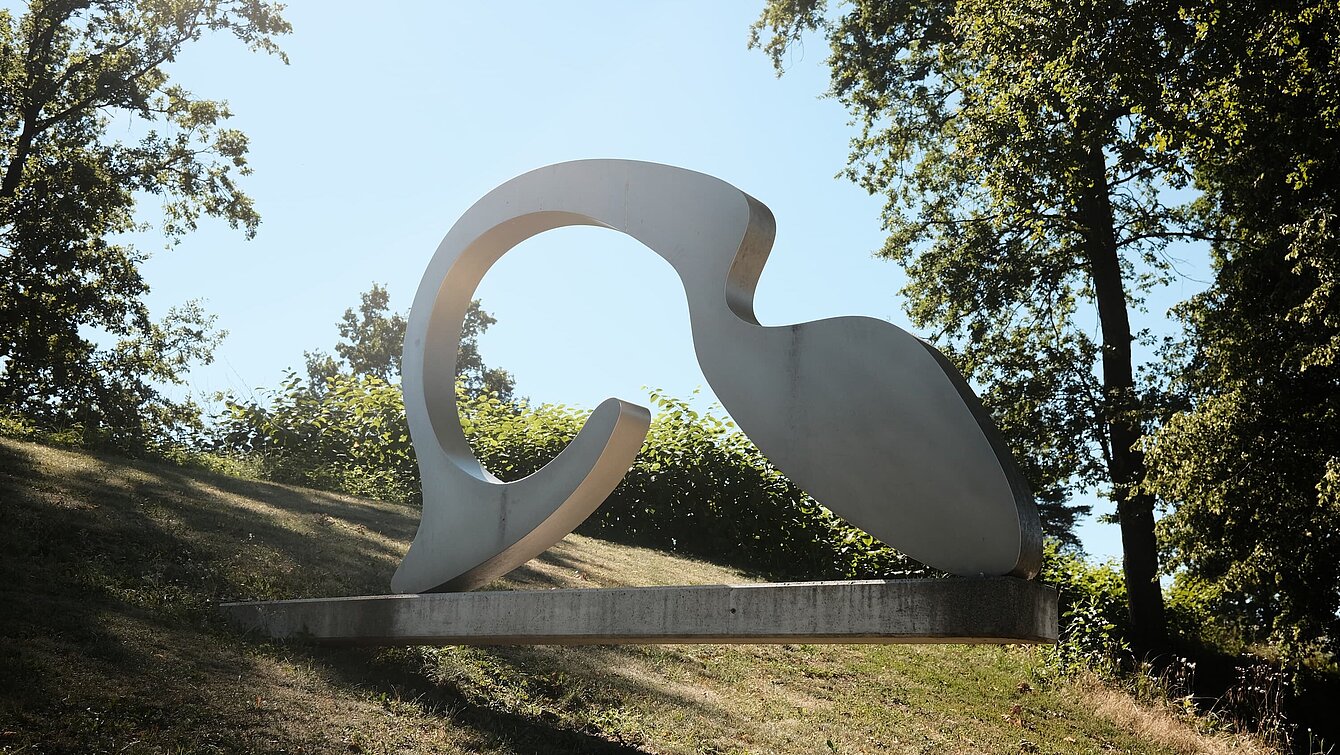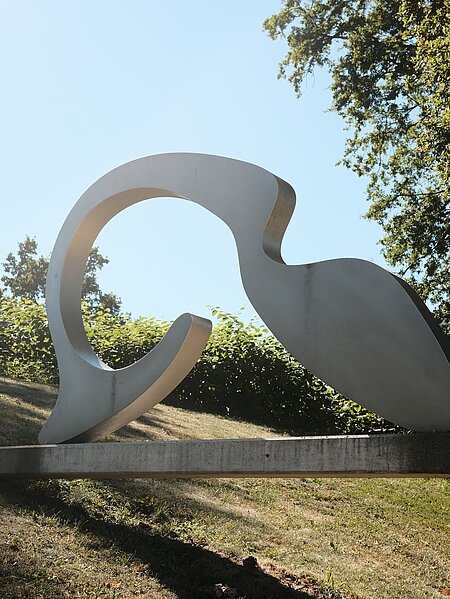During the late 1960s and 1970s, the world was dominated by economic and scientific growth, the orbit around the Earth, the first view of our planet, the moon landing and the computer. Socialised in this period, Wakolbinger develops sculptures from the machine, which dictates its own laws and algorithms. As a result, the artistic signature becomes insignificant. At the same time, the sculpture is reminiscent of the mystic essence of a bird of the gods touching the earth, of capturing the moment, the passage or onward flight. The play of lightness and heaviness is further emphasised by the floating base.
Placement (Giardini)
Manfred Wakolbinger, 2012


Image Credits
Author
Elisabeth Fiedler
Location on map
Position 68
Owner
Österreichischer Skulpturenpark Privatstiftung
Artist biography
Manfred Wakolbinger
Show all
About the sculpture
Manfred Wakolbinger was born in 1952, and grew up in the heyday of hippies and rock’n’roll, the time of psychedelic, psycho-and body analytic reflexion, the cosmological expansion in art, science and society and the simultaneous acknowledgement of human and political incapacity to solve financial, political, social and emotional conflicts in the world.
The confrontation of the inside and outside, the body and mind, including the scope and failure of human innovations in technology and society characterises Wakolbingers artwork. He is fascinated by the first Russian satellite Sputnik, built in 1957, as it passed over Austria as well as by the space probe Voyager 2 who still has been sending pictures to the earth although she exits the solar system in the year 2000.
Joseph Beuys, Chaim Soutine, films by Dennis Hopper, Alejandre Jodorowsky, David Cronenberg, the music of Jimi Hendrix (especially ‘electric skies’), the works of Richard Deacon, Anish Kapoor or Vito Acconci are very important for the imagination and mind of the artist.
Tool-making, metal working, means of industry, construction and jewellery design constitute the basis for his sculptural as well as cinematic and photographical work, internationally exhibited at the Biennale in Venice and the documenta. Copper, concrete and glass in various thickness, reflexion and transparency, are the materials used by Wakolbinger for his artistic works, using them in various ways to gain appropriate shapes of human bodies, architecture and virtual or real spaces.
However, it is not expression he is interested in, rather than in examining the connection between body, machinery, space and time, expansion and inversion, widening and limitation. His sculptures convey a subtle easiness and weightlessness despite the thickness of the used materials which react to its surrounding, change and always challenge our perception.
This is also the case with the sculpture Placement (Giardini) in the Austrian Sculpture Park. The sculpture derives from a series of computer-generated forms, which are rendered as 360° viewable objects, allowing a weightless experience of the object from every angle. The sculptures of the Placement series, created with a 3D-programme, lose their character of an artists imprint and are placed as monumental objects into obscure landscapes or places. One of the physical implemented pieces was adapted for exhibition at the Austrian Sculpture Park.
Similar to sensual experiences during diving or in cosmonautics, Wakolbingers’ artworks lose a certain directedness or intention, while formally referring to organic shapes, such as flowers or parts of trees or bodies, but also to a frozen condition of the current state of mechanical transitions. The sculpture, as Peter Sloterdijk describes it, reminds of a late hatched bird of paradise touching the earth – a frozen moment of a birds’ journey. According to old myths, birds of paradise live exclusively in the air, hatch during flight to immediately spread their wings to fly and generally seem to defy gravity.
The work’s ambivalence between heaviness and lightness, between biomorphic and technic, attendance and absence is additionally emphasised through the floating pedestal. The connection of the sculpture and its base, which is very important to the artist, considering the choice of the materials – concrete for the sculpture and stainless steel for the base – indicates a merger of both materials, but also lets the sculpture appear to be floating above the base or to raise itself from it in pure ease.
The works’ subtitle Giardini is intentionally chosen by Wakolbinger due to its environment. The duality-meanings as listed above, that are so important to the artist, are conveyed to our contemplation since the observers’ perception is influenced by the particular surrounding. Wakolbingers’ belief that thoughts are dependent on the places we are in, lets the visitor enter a dialog with his work.
Referring back to the „negative horizon“ by Paul Virilio, which denotes the form of space filled by the air and thus the space between us and the objects around us, the sculpture is exposed to but also influenced by space and time and hence comes into contact with us. Thus, we can dive into the artwork, are attracted to it and are influenced by its state of uncertainty in order to create associations between remembrance and oblivion, elaboration and absorption, emergence and disappearance.
Set as a state of conversion and as a process of transformation, the sculpture abandons any heaviness, withdraws from any fixation and at the same time enters our mind and subconsciousness as open sign in order to create something new out of it.



















